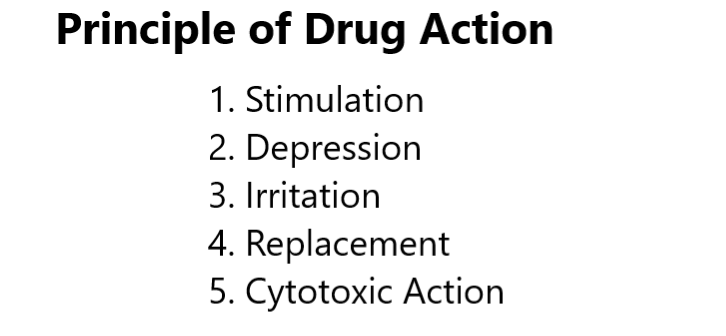Learn principle of drug action in pharmacodynamics. How drugs work in our bodies? Explore the different types of drug actions. How they impact our health?

Pharmacodynamics is the study of drug effects. This study shows how medicines work in our body, what they do, how they do it. It also checks how much medicine we need to work and how one medicine can change the effects of another. It is all about understanding how medicines affect us and interact with each other.
Principle of Drug Action
Drugs (except those gene based) do not impart new functions to any system, organ or cell. They only alter the pace of ongoing activity. However, this alone can have profound medicinal as well as toxicological impact. The principle of drug action can be described by these basic types of drug action are:
Stimulation
This involves boosting the activity of specialized cells. For example, adrenaline stimulates the heart, while pilocarpine stimulates salivary glands. Excessive stimulation can lead to the depression of that function. For example, a high dose of picrotoxin (a central nervous system (CNS) stimulant) can cause convulsions followed by coma and respiratory depression.
Depression
This refers to the reduction in activity of specialized cells. Barbiturates can depress the CNS; quinidine can depress the heart and omeprazole can depress gastric acid secretion. Some drugs can stimulate one type of cell while depressing another. For example, acetylcholine stimulates intestinal smooth muscle but depresses the SA node in the heart. Thus, most drugs cannot be easily classified as strictly stimulants or depressants.
Irritation
This term is used to describe a non-selective, often harmful effect, particularly on less specialized cells like epithelium and connective tissue. Severe irritation can lead to inflammation, corrosion, necrosis and structural damage. This can result in a loss or reduction of function.
Replacement
This involves using of natural metabolites, hormones or their counterparts to decrease the deficiency. Examples include levodopa for Parkinson’s disease, insulin for diabetes mellitus, and iron for anemia.
Cytotoxic Action
Some drugs selectively target unwanted parasites or cancer cells, weakening them without significantly affecting healthy host cells. These drugs are used to treat or alleviate infections and tumors. Notable examples include penicillin, chloroquine, zidovudine and cyclophosphamide.
This is about the Principle of Drug Action in pharmacology.
You may also like Metabolism reactions: synthetic and non-synthetic reaction.
SAQ and Answers:
1.What is pharmacodynamics and what does it study?
Answer: Pharmacodynamics is the study of drug effects, including how medicines work in the body, what they do, and how they do it.
2.Describe the concept of stimulation as a type of drug action. Provide an example.
Answer: Stimulation involves boosting the activity of specialized cells. For example, adrenaline stimulates the heart.
3. What can excessive stimulation of specialized cells lead to, as mentioned in the article?
Answer: Excessive stimulation can lead to the depression of that function. For example, a high dose of picrotoxin can cause convulsions followed by coma and respiratory depression.
4. Explain the term “depression” in the context of drug action. Give an example.
Answer: Depression refers to the reduction in the activity of specialized cells. Example, barbiturates can depress the central nervous system (CNS).
5. Can drugs have both stimulant and depressant effects simultaneously? Provide an example.
Answer: Yes, some drugs can stimulate one type of cell while depressing another. For example, acetylcholine stimulates intestinal smooth muscle but depresses the SA node in the heart.
6. Define “irritation”. What can severe irritation lead to?
Answer: Irritation is a non-selective, often harmful effect on less specialized cells like epithelium and connective tissue. Severe irritation can lead to inflammation, corrosion, necrosis and structural damage, resulting in a loss or reduction of function.
7. What is the concept of “replacement” in drug action and provide examples.
Answer: Replacement involves using natural metabolites, hormones or their counterparts to address deficiencies. Examples include levodopa for Parkinson’s disease, insulin for diabetes mellitus and iron for anemia.
8. Briefly explain the term “cytotoxic action” and provide notable examples.
Answer: Cytotoxic action involves drugs selectively targeting unwanted parasites or cancer cells, weakening them without significantly affecting healthy host cells. Examples include penicillin, chloroquine, zidovudine and cyclophosphamide.
9. Why is understanding the principle of drug action important for both medicinal and toxicological purposes?
Answer: Understanding drug action is important to determine how drugs affect the body and how they interact with each other. It helps ensure the safe and effective use of medications while also identifying potential toxicological risks.
